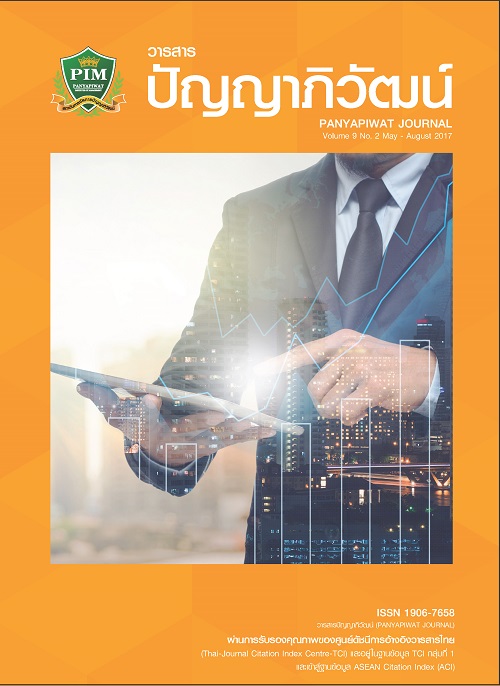การพัฒนาตัวแบบการประเมินความเสี่ยงตามปรัชญาของเศรษฐกิจพอเพียงโดยการบูรณาการความเสี่ยงทางธุรกิจและบริบทของวิสาหกิจชุมชนในจังหวัดสมุทรปราการ
Main Article Content
บทคัดย่อ
งานวิจัยนี้มีวัตถุประสงค์เพื่อ 1) พัฒนาตัวแบบประเมินความเสี่ยงต้นแบบ 2) พัฒนาตัวแบบประเมินความเสี่ยงเบื้องต้น และ 3) พัฒนาตัวแบบประเมินความเสี่ยงขั้นสุดท้าย ตามปรัชญาของเศรษฐกิจพอเพียงของวิสาหกิจชุมชนในจังหวัดสมุทรปราการ เป็นการวิจัยแบบผสมผสานคือ มีทั้งการวิจัยเชิงคุณภาพ และเชิงปริมาณ ประชากรคือ วิสาหกิจชุมชนในจังหวัดสมุทรปราการ จำนวน 283 แห่ง โดยมีการกำหนดจำนวนตัวอย่าง การคัดเลือกและสุ่มตัวอย่าง รวมทั้งมีเครื่องมือในการรวบรวมข้อมูลที่เหมาะสมตามแต่ละขั้นตอนของการวิจัยและพัฒนา สำหรับสถิติที่ใช้ในการวิเคราะห์ข้อมูล ได้แก่ ร้อยละ ค่าเฉลี่ย ส่วนเบี่ยงเบนมาตรฐาน ANOVA และ F-test ผลการศึกษาพบว่า 1) สามารถสร้างตัวแบบประเมินความเสี่ยงต้นแบบได้ และการประเมินค่าตัวแบบการประเมินความเสี่ยงต้นแบบจากผู้เชี่ยวชาญอยู่ในเกณฑ์ที่สามารถนำไปใช้งานได้ แต่ต้องปรับปรุงบางส่วนเพื่อให้สามารถใช้งานได้ดี 2) สามารถพัฒนาเป็นตัวแบบประเมินความเสี่ยงเบื้องต้นได้และการประเมินค่าตัวแบบประเมินความเสี่ยงเบื้องต้น โดยนำไปทดลองใช้งานกับวิสาหกิจชุมชน 3 แห่ง อยู่ในระดับปานกลาง ถึงระดับมาก และยังมีส่วนที่ต้องปรับปรุง 3) สามารถพัฒนาเป็นตัวแบบประเมินความเสี่ยงขั้นสุดท้ายได้ และการประเมินค่าตัวแบบประเมินความเสี่ยงขั้นสุดท้าย โดยวิธีการออกแบบกึ่งทดลองจากกลุ่มควบคุมและกลุ่มทดลองกลุ่มละ 48 วิสาหกิจชุมชน ปรากฏว่ากลุ่มทดลองมีค่าเฉลี่ยของคะแนนการประเมินในภาพรวมสูงกว่ากลุ่มควบคุม โดยมีความแตกต่างอย่างมีนัยสำคัญระดับ 0.05
The main purposes of this research were: 1) to develop prototype of risk assessment model, 2) to develop initial product of risk assessment model, and 3) to develop final product of risk assessment model as sufficiency Economy Philosophy of Community Enterprise in Samut Prakan Province. These were mixed research with both qualitative and quantitative research. The population were 283 community enterprises. Sample size, random sampling and instruments depended upon each of research stages and assigned appropriately. Statistical analysis were percentage, mean, standard deviation, ANOVA and F-test. The research results were: 1) construction of the prototype and evaluation result of prototype by the specialists, which the model was benefit for using but it need to be improved, 2) development had to do initial product of risk assessment model and evaluation result of initial product by testing 3 community enterprises, which were ranked from moderate to high level and need to be improved, and 3) development had to do final product of risk assessment model and evaluation result of final product by semi-experimental design that had testing of 48 community enterprises in each of control group and trail group. The results were different at significance level 0.05 and trail group was higher than control group.
Article Details
“ข้าพเจ้าและผู้เขียนร่วม (ถ้ามี) ขอรับรองว่า บทความที่เสนอมานี้ยังไม่เคยได้รับการตีพิมพ์และไม่ได้อยู่ระหว่างกระบวนการพิจารณาลงตีพิมพ์ในวารสารหรือแหล่งเผยแพร่อื่นใด ข้าพเจ้าและผู้เขียนร่วมยอมรับหลักเกณฑ์การพิจารณาต้นฉบับ ทั้งยินยอมให้กองบรรณาธิการมีสิทธิ์พิจารณาและตรวจแก้ต้นฉบับได้ตามที่เห็นสมควร พร้อมนี้ขอมอบลิขสิทธิ์บทความที่ได้รับการตีพิมพ์ให้แก่สถาบันการจัดการปัญญาภิวัฒน์หากมีการฟ้องร้องเรื่องการละเมิดลิขสิทธิ์เกี่ยวกับภาพ กราฟ ข้อความส่วนใดส่วนหนึ่งและ/หรือข้อคิดเห็นที่ปรากฏในบทความข้าพเจ้าและผู้เขียนร่วมยินยอมรับผิดชอบแต่เพียงฝ่ายเดียว”
References
Boonratanasoontorn, J. & Komonta, M. (2009). Analysis of State policy in Multilevel from Sufficiency Economy Philosophy (1997-2006)(1st ed.). Bangkok: The Thailand Research Fund. [in Thai]
Brown, W. B. & Moberg, D. J. (1980). Organization theory and Management: A Macro Approach.New York: John Wiley and Sons.Chandarasorn, V. (2011). The Application of the Philosophy of Sufficiency Economy into the Management of Public Sector. Panyapiwat Journal,2(2), 1-18. [in Thai]
Chantamano, V. (2011). Report of Community Enterprisein Samutprakan Province. Retrieved April 10, 2012, from http://www/sceb.doac.go.th [in Thai]
Choochom, O. (2009). Quasi-experimental research. Journal of Behavioral science,15(1), 1-3. [in Thai]
Chunsom, N. (2012). Sustainable Business and Sufficiency Economy Philosophy. Retrieved March 3, 2014, from http://cse.nida.ac.th/main/images/index.pdf [in Thai]
Cochran, W. G. (1977). Sampling techniques (3rd ed.). Singapore: John Wiley & Sons.Kantabutra, S. (2010). Sufficiency Economy in Sustainable Business Organizations. Bangkok: Thammasat University printing. [in Thai]
Office of the National Economics and Social Development Board. (2007). Application on Principal of Sufficiency Economy. Bangkok: Office of the National Economics and Social Development Board. [in Thai].
_________(2008). From Sufficiency Economy Philosophy to Practice. Bangkok: Phet-roong printing. [in Thai].
_________(2012). The Eleventh National Economic and Social Development Plan(2012-2016).Bangkok: Office of the National Economics and Social Development Board. [in Thai]
Pattaramontri, A. (2003). Modern Internal Auditing. Bangkok: Kasetsart University. [in Thai]
PricewaterhouseCoopers. (2004). Guidelines on the Risk management. Bangkok: The stock Exchange of Thailand. [in Thai]
Puntasen, A., Suksirisereekul, S. & Suzuki, P. (2002). Benchmarking in the context of rural community business. Retrieved March 3, 2014, from http://www.openbase.in.th/apichai [in Thai]
Secretariat Office of Community Enterprise Promotion Board. (2012). Summary of amount of Registered Community Enterprise and network. Retrieved May 20, 2012, from http://www.sceb.doac.go.th [in Thai]
Smith, R. H. et al. (1980). Measurement Making Organization Perform. New York: Macmillan.
Thippayakraisorn, S. (2012). Business Continuity Management...The Way Out of Crisis. Panyapiwat Journal, 4(1), 68-77. [in Thai]

